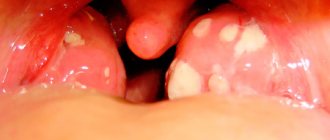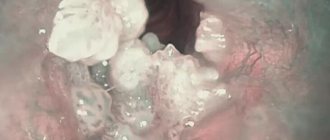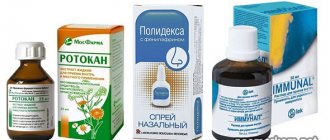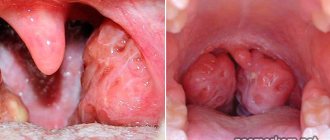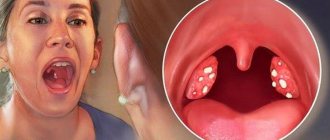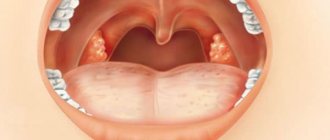If a person has a history of a diagnosis of “chronic tonsillitis,” then such a patient knows firsthand what plugs in the throat, or more precisely in the tonsils, are.
Pus plugs are one of the tonsillitis manifestations of inflammation of the tonsils. They represent an accumulation of remnants of the vital activity of bacteria and leukocytes that died in the fight against them. They also contain phosphorus, calcium and ammonia.
If you look at the palatine tonsil, its surface appears smooth. But in fact, each tonsil is permeated through and through with narrow winding canals - crypts, which end on the surface of the tonsils with openings - lacunae. It is these tortuous crypts and lacunae that become the site of bacterial dislocation and the formation of purulent accumulations. In healthy palatine tonsils, the self-cleaning function works well, which allows you to independently remove the contents of the lacunae. Inflamed tonsillitis glands cannot cope with this function. In chronic tonsillitis, plugs accumulate and cause discomfort. The medical name for tonsillitis plugs is caseous detritus. Their size usually varies from one millimeter to several centimeters. There may be several such clusters in the tonsil, but there are cases when plugs dot the entire surface of the tonsils.
About congestion in the throat
Every person has experienced pain, discomfort and a feeling of congestion in the throat many times in their lives.
This is due to the fact that a common cold, which is accompanied by swelling of the pharyngeal mucosa, irritates the nerve endings, creating pain and soreness in the throat. In many cases, an acute process, provided that immunity is not reduced, can be well treated at home in such a way as: gargling, drinking plenty of fluids. And yet, treating an inflammatory disease of the pharynx on your own at home is wrong, and therefore, against the background of such a disease, a chronic disease of the pharynx can develop: pharyngitis, chronic tonsillitis, and even chronic laryngitis. In certain cases, symptoms may appear: anxiety, a lump in the throat and bad breath.
Video treatment of chronic tonsillitis without surgery, 12:47 min.
When you have a sore throat, it is very common to look at your mouth in a mirror. Upon examination, you can see purulent plugs in the throat, white-yellow lumps of a cheesy nature with a rather unpleasant odor, emerging from the mucous membrane of the side walls of the pharynx. Such formations are called caseous plugs, which emerge from the lacunae of the palatine tonsils.
If you suddenly notice plugs in your throat of this nature, then you most likely have chronic tonsillitis. This disease is caused by inflammation in the palatine tonsils. The palatine tonsils are the same tonsils, a collection of lymphoid tissue that is limited from the lateral walls of the pharynx by a capsule. A special feature of the palatine tonsils is their anatomical structure.
Washing the lacunae of the tonsils
This method is considered the most effective for removing not only caseous plugs, but also purulent accumulations. It can be carried out:
- Using a syringe. An antiseptic solution is drawn into a sterile syringe, after which a special attachment (thin and curved) is put on it instead of a needle. It is this that is injected into the gaps (the 2-3 largest ones) and the pressure of the antiseptic washes out purulent and other contents from there.
- Vacuum device. Before the procedure, the mucous membrane of the tonsils is anesthetized (usually with lidocoine). Then a “cup” that fits tightly to the surface is placed above the tonsil, after which negative pressure is created using a vacuum, which removes the contents from the lacunae. After the procedure, an antiseptic solution is introduced to prevent the formation of new plugs.
Typically, such treatment is carried out in a course (10-15 procedures every other day).
Why shouldn't you remove throat plugs yourself?
If chronic tonsillitis has reached the stage of formation of plugs in the throat, then you will not be able to get rid of them on your own, without resorting to the help of a doctor. Quite often, the majority of those who encounter blockages in the throat, given the pain and bad breath, resort to removal on their own. This is achieved by pressing on the tonsil with your fingers, picking out plugs from the lacunae with a spoon or match. This method is categorically inappropriate, since the superficial part of the plug is removed, and not the depth of the tonsil.
Congestion in the throat is the result of pathomorphological processes that occur in the palatine tonsils as a result of chronic inflammation. Also, along with plugs in the throat, liquid fractions of pus may be present. Therefore, in order to get rid of congestion in the throat, it is necessary to influence all important components of the pathogenesis of chronic tonsillitis .
Independent methods of removing plugs in the throat will only aggravate the course of the disease (traumatization of tonsil tissue), which will further activate the scarring process in the area of the lacunae, which ultimately complicates the process of evacuation of purulent plugs. Neither all kinds of rinsing, nor other methods of self-medication will help properly, which, on the contrary, can ultimately lead to decompensation of chronic tonsillitis and the creation of plugs in the throat.
Rinse
Local antiseptics used for rinsing have not only antibacterial, but also anti-inflammatory and analgesic effects. So, for the treatment of tonsillitis plugs, doctors recommend the following remedies:
Miramistin
For rinsing, use a 0.01% solution of Miramistin. A single dosage is 10-15 ml of the product (or 1 tablespoon), it does not need to be diluted with water. Directions for use: 30-40 minutes after eating, pour Miramistin solution into the mouth and gargle for 1-2 minutes, then spit out the product. Perform at least 4-5 times a day. The course of treatment is 10 days.
Furacilin
To prepare 200 ml of solution you need:
- Grind two Furacilin tablets to a powder (with a mortar or spoon).
- Pour the resulting powder into a glass and add 200 ml of warm water.
- After waiting for complete dissolution, mix and strain through cheesecloth.
Gargle up to 6-7 times a day, using the entire single portion of the product (200 ml). Course of treatment: 7-10 days.
Chlorhexidine
A 0.05% solution is suitable for rinsing. Before the procedure, it is recommended to first rinse your throat with warm water. Then gargle with Chlorhexidine for 30 seconds (single dosage: 1 tbsp). Do not eat or drink anything for the next hour. Perform the procedure 3-4 times a day for 5-7 days.
Soda-salt solution
To prepare the product you will need:
- Dissolve 1 tsp in a glass of warm water (approximate temperature 38-40 degrees). salt and baking soda.
- To increase efficiency, you can add a couple of drops of iodine.
Rinse up to 5-6 times a day. During and after the procedure, a slight burning sensation in the throat is possible. Approximate course of treatment: 7-10 days.
Note! In addition to rinsing, to increase the effectiveness of therapy, you can lubricate the inflamed tonsils with Lugol's solution 2-3 times a day (for example, using a cotton swab). The drug stops the spread of infection and facilitates easier separation of purulent plugs.
Causes of purulent plugs in the throat
Unpleasant sensations and pain in the throat accompany any person throughout the illness. The symptoms and consequences of a disease such as a congestion in the throat may be different for everyone, and are determined only by a medical specialist. Diagnostics involves a blood test, smear and other medical procedures that allow you to correctly establish a diagnosis and prescribe effective treatment. Redness and sore throat can be eliminated at home, but purulent plugs in the throat of various etiologies certainly require special treatment and attention.
The cause of purulent plugs in the throat can be different. But the result of any cause may be inflammation of the tonsils. The tonsils are lymphoid tissue that protect the throat from various infections. A severe inflammatory process in the tonsils can be caused by various microbes, which is why a correct diagnosis can only be made by obtaining a smear of the larynx.
Sore throat can be caused by microbes such as streptococcus, pneumococcus, staphylococcus or adenoviruses, and diphtheria - by diphtheria microbes. Only timely treatment of purulent plugs in the throat will help avoid serious complications .
Use of antibiotics
Antibiotics are prescribed in case of purulent processes in the tonsils in order to stop the further spread of infection. As a rule, the drug is selected after taking a smear from the tonsils and determining the sensitivity of the bacteria living in it to certain drug substances. The use of penicillin antibiotics (ampicillin, amoxiclav) is often recommended.
Sometimes the analysis is not carried out, and in this case broad-spectrum drugs belonging to the group of cephalosporins (ceftriaxone, suprax) or macrolides (sumamed, azithromycin) are prescribed. They are used as prescribed orally, administered locally to the tonsils or for inhalation.
Purulent plugs in the throat in children and adults
In children of younger and older age categories, sore throat can often be observed with purulent plugs in the throat. Follicular and lacunar tonsillitis is marked by yellow and white purulent plugs; blisters with pus cover almost all the tonsils. The disease is accompanied by headaches, fever, general weakness, and loss of appetite. There are strong changes in the blood test, they are associated with a high content of leukocytes.
If there is suddenly a suspicion of diphtheria sore throat, the sick child should be hospitalized immediately. This disease is very dangerous with all sorts of complications in the future. Diphtheria is marked by purulent gray deposits, which cause great pain when removed. Suspicion of such a disease may arise already at the first examinations.
Parents often have questions about tonsil removal; such advice can only be given by the attending physician. Often, a child can simply “outgrow” tonsil disease, but if there is a serious risk of complications in the heart, joints and kidneys, then it is worth consulting with experienced specialists before making a decision.
Adult patients often turn to the doctor with the same questions about purulent plugs in the throat. A person constantly suffers from sore throat, pharyngitis, and purulent plugs in the throat are caused by the same diseases. Reduced immunity, poor environmental conditions, improper self-medication - all this causes chronic tonsillitis (chronic inflammation of the tonsils). With periodic exacerbations, chronic tonsillitis manifests itself as sore throat. The constant appearance of purulent plugs in the throat and bad breath bring anxiety and exhaust the patient.
An extremely dangerous complication is in the form of a peritonsillar abscess, which turns into phlegmon of the neck, which threatens the patient in case of negligence in the treatment of chronic tonsillitis. Diseases of the joints, heart and kidneys are very dangerous, as complications after previous diseases associated with the presence of purulent plugs in the throat.
Diagnostics
If multiple purulent accumulations of several millimeters in size are detected (including painful sensations), you must consult an otolaryngologist (ENT) and undergo an examination. Otherwise, the situation may worsen, which will subsequently lead to complications.
In addition to a general examination and analysis of the patient’s complaints, patients undergo the following diagnostic procedures:
- Palpation - feeling the neck, larynx and lymph nodes for pain.
- Pharyngoscopy - examination of the pharynx and pharynx using a special mirror for the presence of plugs, redness and swelling.
- General blood test - allows you to identify pathogens in the body (or their absence).
- A smear from the inflamed area - to determine the microflora of the tonsils.
- X-ray of the paranasal sinuses - prescribed for prolonged runny nose and nasal congestion.
Treating throat congestion
Congestion in the throat and bad breath can be so distressing that patients are often ready to resort to any measures, even removal of the tonsils (tonsillectomy). Such a solution in certain cases is very acceptable, but the point is that any operation must be seriously justified. Sometimes, having rushed to remove the tonsils and upset the anatomy and the natural protective mechanisms of the pharynx, in the near future a person may encounter a form of chronic pharyngitis, which is very difficult to treat and intensively worsens the quality of life. That is why, if you have plugs in your throat, do not under any circumstances delay removing your tonsils.
Congestion in the throat is not an indication for tonsillectomy, taking into account all the canons of otorhinolaryngology. With the right approach to treating purulent plugs in the throat, you can do without surgery, solving the problem in a conservative way . The ENT-Asthma clinic has developed and successfully used an effective method for treating chronic tonsillitis, consisting of a set of procedures. All actions are aimed, first of all, at eliminating all the important links in the pathogenesis of this disease, which allows you to actually get rid of congestion in the throat, preserving the tonsils.
Irrigation
Irrigations are perfect for people who, for some reason, cannot rinse (for example, the elderly, small children). Such drugs are available in the form of aerosols (just spray the product onto the affected area). Here are some of them:
- Inhalipt - shake the bottle and spray the product into the mouth for 1-2 seconds. Carry out the irrigation procedure 3-4 times a day. Course of application: 5-7 days.
- Chlorophyllipt - spray into the mouth for 2 seconds, use 2-3 times a day. Course of application: 1 week.
- Cameton - spray the product into the mouth for 1-2 seconds, repeat the procedure 3-4 times a day. To improve performance, use the drug for a week (without skipping).
Possible consequences
In the absence of timely treatment, the following consequences are possible:
- Peritonsillar abscess (infection penetrates into the tissues adjacent to the tonsils and causes purulent abscesses).
- Cellulitis of the neck (purulent inflammation of the tissue).
- Sepsis (pathogenic microorganisms spread through the bloodstream throughout the body, causing damage to certain organs).
- Kidney failure (an extreme form of complication).
- Inflammation of the joints (streptococci penetrate the bloodstream and cause swelling of the lower extremities).
Inhalations
For inhalation, it is recommended to purchase a nebulizer device into which the medication is poured. But you can get by with improvised means (for example, breathe over a pan of hot steam, covering your head with a towel). The duration of one procedure is 5-10 minutes. Frequency of use: 3-4 times a day. You need to inhale the steam very slowly.
So, for inhalation, decoctions of medicinal herbs are used (1-2 tsp per glass of boiling water):
- Chamomile flowers.
- Sage.
- Eucalyptus, etc.
Inhalations should not be carried out after walking in the fresh air. Upon completion of the procedure, you must dress as warmly as possible and avoid drafts in the room.
